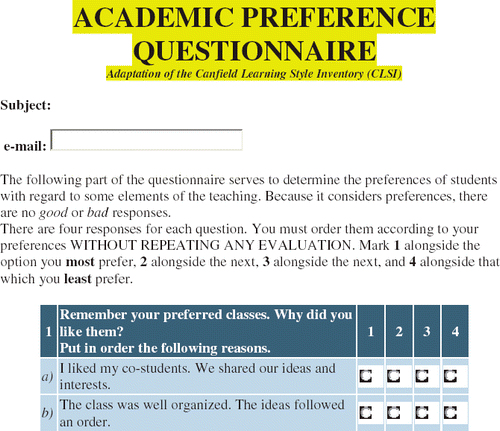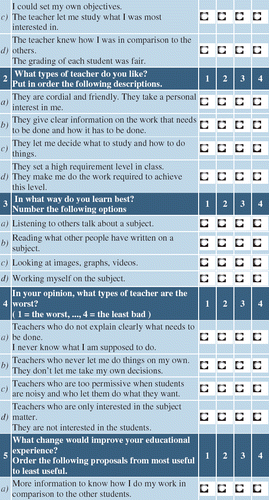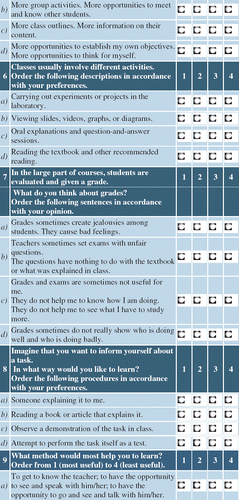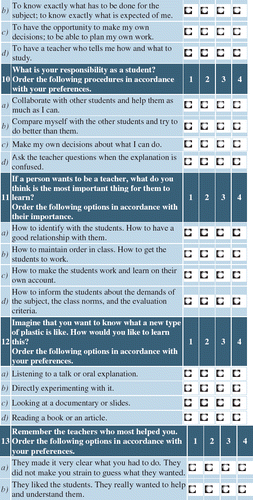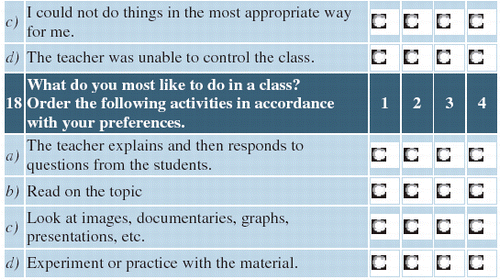Abstract
Background: Problem-Based Learning (PBL) is a whole-curriculum concept.
Aim: This study aimed to compare learning preferences and strategies between physical therapy students taught by PBL and those receiving conventional lectures on massage therapy, trauma physical therapy, and electrotherapy, hydrotherapy, and thermotherapy.
Methods: This quasi-experimental study included 182 male and female students on physical therapy diploma courses at three universities in Andalusia (Spain). The Canfield Learning Skills Inventory (CLSI) was used to assess learning strategies and the Approaches to Study Skills Inventory for Students (ASSIST) to analyze study preferences.
Results: At the end of the academic year 2009/10, physical therapy students taught by PBL considered the most important learning strategies to be group work, study organization, relationship of ideas, and academic results. In comparison to conventionally taught counterparts, they considered that PBL reduced lack of purpose, memorizing without relating, the law of minimum effort, and fear of failure. Among these PBL students, the most highly rated study preferences were: organization of course tasks, cordial interaction with the teacher, learning by reading and images, and direct hands-on experience.
Conclusion: For these physical therapy students, PBL facilitates learning strategies and study preferences in comparison to conventional teaching.
Introduction
The aim of problem-based learning (PBL) is to stimulate independent learning, allowing students to rehearse approaches to complex situations and to develop a definition of their own deficiencies in cognitive understanding (Rodríguez-Suárez Citation2003). PBL is a whole-curriculum concept and not a teaching modality. If it is not feasible to implement the whole concept, implementers may use it as a major learning modality or improve their traditional curriculum by incorporating the educational principles underlying PBL, i.e., learning in context, self-directed learning, and collaborative learning. Different norms, beliefs, values, and external factors give PBL a different flavor and may change it outright (Taylor & Miflin Citation2008). The evolution of PBL variations in different institutions, countries, and continents has been dependent on implementation problems. Reported difficulties include a variable understanding of PBL, and scarcity of resources. The most important factors remain the scarcity of resources, i.e., trained “faculty, facilities and funds” (Zuberi Citation2011).
The authors of the AMEE Guide stress that dissemination of the PBL concept has created confusion in the understanding and practice of this learning, leading to difficulties in interpreting PBL research findings PBL. Other possible causes of differences include an incomplete training of educators in the appropriate skills and an excessive haste in designing PBL curricula, leading to a poor preparation and inadequate staff training (Azer Citation2011). The concept of self-directed learning (SDL) is considered central to adult learning and PBL. However, several authors have raised concerns about this generalization and questioned whether SDL can be automatically achieved by the introduction of a PBL curriculum. In PBL, students direct their learning by identifying unknown issues in relation to the case. SDL develops competencies, skills, and attitudes that foster the learning process. The authors of the AMEE Guide highlighted the role of small group work in PBL, providing the security and authority that students need for their own learning (Barrows & Tamblyn Citation1980; Maudsley et al. Citation2010; Azer Citation2011).
Physical therapy curricula have traditionally followed a content-based behaviorist model, with teachers deciding the learning needs and methods of their students. The theoretical preparation tends to incorporate practice elements in order to familiarize students with the process involved in problem-solving (Hartling et al. Citation2010). PBL is closely related to evidence-based physical therapy, which was developed to improve the quality of physical therapeutic care and optimize the utilization of limited resources. Evidence-based decision-making is based on the findings of the most recent high-quality research, and there is wide agreement that the methodology required for this approach should be taught throughout university courses (Wolf Citation2000; Abdelkhalek et al. Citation2010). Evidence relevant to clinical practice is related to the cause, diagnosis, prevention, and treatment of diseases. Importantly, the evidence-based model should be regarded as adding a further dimension to the decision-making process rather than replacing the judgment and experience of clinicians (Hofgaard et al. Citation2006).
Albanese and Mitchell (Citation1993) reviewed seven studies that compared faculty supervisors’ clinical ratings between medical school graduates from PBL programs and those from conventional courses, consistently reporting more positive clinical ratings for the PBL students. Students from a Dutch medical school running a PBL program reported higher satisfaction with their training and interpersonal skills preparation in comparison to students from two schools with conventional curricula, but no differences were found in their ability to manage clinical cases (Busari et al. Citation1997; Rideout et al. Citation2002; Hendry et al. Citation2006). A study on perceived changes in self-directed learning over 4 years in a baccalaureate nursing education program with an integrated problem-based learning curriculum supported SDL as a maturational process (Kocaman et al. Citation2009).
Integration within the European Higher Education Area (EHEA) is a prime objective of Spanish universities and implies the reconsideration of conventional teaching methods and the introduction of alternative quality models. A key requirement of the Bologna Declaration on which the EHEA is based is that teaching be centered on student work. Learning strategies are located at the same hierarchical level as the thematic knowledge specific to each discipline. They are integrated within a planned sequence of actions and are flexibly adjusted and adapted as a function of the learning context. The development of different learning and rating strategies can disorientate students to some degree, and teachers need to study the profiles and learning needs of their students and seek ways to improve the learning environment. During the academic year 2009/10, the discipline of physiotherapy at the Universities of Granada, Almeria and Cadiz was included in new study plans introduced into Spanish universities as a result of the Bologna Declaration, and a PBL approach was adopted for both the theoretical and practical content of these courses. With this background, the objective of this study was to compare learning preferences and strategies between physiotherapy students taught by PBL (academic year 2009/10) and those taught by conventional lectures (academic year 2008/09) in the subjects of massage therapy, physiotherapy, electrotherapy, hydrotherapy, and thermotherapy.
Method
Design
This study had a quasi-experimental design, since the participation of students in the different courses was not randomized. The courses were in massage therapy (University of Almeria), trauma physical therapy (University of Granada), and electrotherapy, hydrotherapy, and thermotherapy (University of Cadiz). The study period was from September 1 2008 to July 31 2010.
Study sample
The study included 182 male and female students on the Diploma Course in Physical therapy at three Universities in Southeastern Spain (University of Granada [n = 62], University of Almeria [60] and University of Cadiz [n = 60]) during the academic year 2008/09. During the academic year 2009/10, the number of students was 176 (University of Granada [n = 61], University of Almeria [58] and University of Cadiz [n = 57]). Data on students repeating the subject were excluded from the analyses. Written informed consent was obtained from the students in accordance with the Helsinki Declaration (2000 modification). The study was approved by the ethical and research committees of all three universities.
Measurement instruments
We used the Approaches to Study Skills Inventory for Students (ASSIST) to analyze study preferences and the Canfield Learning Styles Inventory (CLSI) to assess learning strategies.
The ASSIST questionnaire evaluates the use of learning strategies in study activities and the quality of the learning obtained. Three categories are considered: Superficial Learning (search for significance, relationship of ideas, use of evidence, interest in ideas); Strategic Learning (lack of purpose, memorizing without relating, law of minimum effort, fear of failure); and Deep Learning (organized study, time management, attention to task demands, achievements, and effectiveness monitoring). Students respond to questions on their study habits, and scores for each item are added together to obtain sub-scale scores (Tait & Knight Citation1996).
A Spanish adaptation of the CLSI Questionnaire (Canfield Citation1992) was used, which contains two of the three categories in the original, i.e., Learning Conditions and Modes of Learning. The Learning Conditions category comprises eight subscales:
Classmates, valuing a good relationship with other students for effective learning
Organization, valuing a clear and logical organization of tasks
Objectives, valuing the opportunity to modify objectives or procedures
Competition, valuing comparisons with other students as motivational
Teacher, valuing a cordial interaction between teacher and students
Details, valuing specific and detailed information
Independence, valuing the independent work of student
Authority, valuing discipline and order in class and the controlled development of study activities.
Procedure
Participating students completed the two questionnaires (pre-test) during the first week of the academic year 2008/09 after signing their informed consent to participation in the study. During this academic year, massage therapy, trauma physical therapy, and electrotherapy, hydrotherapy, and thermotherapy were taught in a conventional manner, with lectures for the theoretical content plus individual learning in theoretical-practical classes. For massage therapy, 10 hours (1-h classes) were assigned to theory and 120 hours to theoretical-practical content; for trauma physical therapy, 30 hours were assigned to theory and 230 hours to theoretical-practical content; and for electrotherapy, hydrotherapy and thermotherapy, 25 hours were assigned to theory and 100 hours to theoretical-practical content. All subjects were assessed by a test-type exam and a theoretical-practical exam at the end of each course. Each student completed the two questionnaires (post-test) again during the last week of the academic year 2008/09.
During the academic year 2009/10, these three subjects were included in the new study plans introduced into Spanish universities as a result of the Bologna Declaration, and a PBL approach was adopted for both the theoretical and practical content of these courses. The development and implementation of PBL followed the sequence described in . All students on these courses completed the ASSIST and CLSI questionnaires in the first and last weeks of the academic year.
Table 1. Sequence of development and implementation of PBL
Statistical analysis
SPSS version 18.0 was used for the data analyses. The reliability and validity of the model hypothesis were studied by analyzing the residual independence, normal distribution, and homogeneity of variances. After descriptive study of the demographic variables, residual independence was analyzed by plotting observed against residual values; data points were randomly distributed and showed no trend, verifying the hypothesis of residual independence. The Kolmogorov-Smirnof test was used to examine the normal distribution of variables. An imputed score was calculated for standardized scales missing ≤ 10% of responses. Analysis of variance (ANOVA) was used to analyze differences within each academic year and the Student's t- test for independent samples to analyze differences between academic years. p < 0.05 was considered significant in all tests.
Results
In the academic year 2008/09, the study sample included 182 students (massage therapy course, n = 58; trauma physical therapy course, n = 61; electrotherapy, hydrotherapy, and thermotherapy course, n = 57). After excluding students who were repeating the course (n = 6), the study sample in the academic year 2009/10 comprised 58 students on the massage therapy course (mean age 21.43 yrs), 61 students on the trauma physical therapy course (mean age, 20.12 yrs), and 57 students on the electrotherapy, hydrotherapy, and thermotherapy course (mean age 19.96 yrs).
Learning strategies (ASSIST)
No significant differences in scores were found between ASSIST results at the beginning of the two academic years (). No significant differences in results were found between the beginning and end of the academic year 2008/09 (conventional classes) (Tables ). After the introduction of PBL, significant differences were found in some item scores between the beginning and end of the academic year (2009/10) for all three subjects (Tables ): massage therapy (interest in the subject, p < 0.030 and lack of purpose, p < 0.019), trauma physical therapy (relationship of ideas, p < 0.001; study organization, p < 0.002; academic results, p < 0.008; lack of purpose, p < 0.006; memorizing without relating, p < 0.001; law of minimum effort, p < 0.008; fear of failure, p < 0.018), and electrotherapy, hydrotherapy and thermotherapy (study organization, p < 0.026; academic results, p < 0.022; lack of purpose, p < 0.002; memorizing without relating, p < 0.001; law of minimum effort, p < 0.001; fear of failure, p < 0.018).
Table 2. Mean pre-test scores on approaches to study skills inventory for students
Table 3. Mean post-test scores on approaches to study skills inventory for students
Table 4. P-value of differences between pre- and post-test scores on approaches to study skills inventory for students
Significant differences were found between the end of each academic year in some items on all courses, as follows: massage therapy (use of evidence, p < 0.043; interest in the subject, p < 0.025; study organization, p < 0.040), trauma physical therapy (relationship of ideas, p < 0.041; academic results, p < 0.032; study organization, p < 0.028; memorizing without relating, p < 0.043), and electrotherapy, hydrotherapy and thermotherapy (lack of purpose, p < 0.023; memorizing without relating, p < 0.027; law of minimum effort, p < 0.034; fear of failure, p < 0.044).
Study preferences (CLSI)
No significant differences in scores were found between CLSI results at the beginning of the two academic years (). In the courses given by conventional lectures in 2008/09, no significant differences were found between the beginning and end of the academic year (Tables ). After the introduction of PBL, significant differences were found between the beginning and end of the academic year (2009/10), as follows: massage therapy (organization, p < 0.019), trauma physical therapy (professor, p < 0.017; images, p < 0.041; direct experience, p < 0.001), and electrotherapy, hydrotherapy and thermotherapy (professor, p < 0.001; reading, p < 0.007; images, p < 0.012; direct experience, p < 0.001).
Table 5. Mean pre-test scores on the Canfield learning skills inventory
Table 6. Mean post–test scores on the Canfield learning skills inventory
Table 7. P-value of differences between pre- and post-test scores on the Canfield learning skills inventory
Significant differences were found between the end of each academic year in the following courses and items: massage therapy (classmates, p < 0.038; organization, p < 0.042), trauma physical therapy (classmates, p < 0.028; professor, p < 0.035; images, p < 0.044), and electrotherapy, hydrotherapy and thermotherapy (professor, p < 0.016; reading, p < 0.023; images, p < 0.031; direct experience, p < 0.024).
Discussion
In this study, physical therapy students taught by PBL developed a greater preference for organization and a good relationship with the teacher and for learning by reading, images and direct experience. In comparison to conventional teaching, student taught by PBL showed significant improvements in the relationship of ideas, interest in the matter, study organization, and academic results, with reductions in lack of purpose, memorizing without relating, the law of minimum effort, and fear of failure.
The PBL-taught students considered that direct hands-on experience was the best learning strategy and facilitated cordial interaction with the teacher. The role of the teachers was transformed in our PBL courses; they were no longer the main source of initial information and had a lesser direct influence on the first steps of the learning process. On the other hand, they were consulted by students on their self-directed learning, and the tutor groups were crucial for organizing the learning tasks.
In comparison to PBL students, those taught by conventional methods were more likely to describe a lack of purpose towards learning, non-association of ideas in memorizing subjects, application of the law of minimum effort (with the teacher generating all of the discourse), and a fear of failure in the clinical setting. The PBL students expressed significantly greater levels of preference for their educational experience in comparison to their conventionally taught counterparts, in agreement with numerous reports on the positive response to PBL by medical and nursing students (Busari et al. Citation1997; Kaufman & Mann Citation1997; Rideout et al. Citation2002; Hendry et al. Citation2006; Kocaman et al. Citation2009; Abdelkhalk 2010; Samy Citation2011). PBL tests the ability of students to function in situations they have yet to encounter, enabling them to identify their learning needs and access appropriate resources. These outcomes were achieved and valued by our students, as also found in previous studies on this educational approach (Rideout et al. Citation2002). In the present study, satisfaction was especially marked on the level of independence provided by the PBL program, relationships with the teaching staff (supportive and positive), and on confidence in their ability to solve problems in clinical practice. Oja (Citation2010) examined the evidence regarding the use of problem-based learning to improve critical thinking. The studies reviewed indicate a positive relationship between problem-based learning and improved critical thinking in nursing students.
It has been proposed that physical therapy programs have less specific objectives in comparison to some other areas of medicine, allowing the students greater scope to interpret and/or negotiate their meaning (Handal et al. Citation1990; Abrandt-Dahlgren & Dahlgren Citation2002). Solomon et al. (Citation1996) compared the performance of physical therapy students from an integrated PBL program with those from a program that introduced PBL into some senior courses in an otherwise conventional curriculum. Higher scores were observed for PBL students in basic and clinical science questions, although the differences did not reach statistical significance. Quantitative studies in medical students on PBL and conventional courses (Kaufman & Mann Citation1997; De Leng et al. Citation2006; Kocaman et al. Citation2009; Abdelkhalek et al. Citation2010; Ki Chan et al. Citation2010) all reported that the former have a more favorable perception of their learning environment. A qualitative study in physical therapy students also found them to have a positive view of the PBL approach (Solomon & Finch Citation1998; Abrandt-Dahlgren Citation2000).
PBL introduces students to carefully constructed problems sequenced according to a logical progression of massage therapy, trauma physical therapy, and electrotherapy, hydrotherapy, and thermotherapy. Physical therapy students taught by PBL reported that they enjoyed the collaborative learning process and appreciated the multiple ways of understanding a topic with their team members and the freedom that the small group offers for face-to-face interaction (Wood Citation2003; Khan et al. Citation2006).
Study limitations
One study weakness was the lack of follow-up during hospital practice stays in order to detect differences in the students’ approach to patients. Post-graduation follow-up of the students would also have been valuable but proved unfeasible due to the large number starting their professional life in other Spanish provinces and states of the European Union. It was not possible to examine differences in knowledge revealed by the theoretical-practical examinations, which were conducted in pairs, with different questions on the practical case under review for each individual student. Finally, although the students were not informed of the study hypothesis, they may have come to realize its nature.
Conclusion
For these physical therapy students, the main contribution of PBL is its enhancement of group work, study organization, the relationship of ideas, and academic results. In comparison to conventionally taught counterparts, physical therapy students considered that PBL reduced lack of purpose, memorizing without relating, the law of minimum effort, and fear of failure. PBL-taught students placed greater value on the organization of course tasks, cordial interaction with the professor, and learning by reading, images, and direct hands-on experience. The PBL evaluated in this study is a teaching/learning method to facilitate learning strategies and study preferences in physical therapy students.
Declaration of interest: The authors report no conflicts of interest. The authors alone are responsible for the content and writing of the article.
References
- Abdelkhalek N, Hussein A, Gibbs T, Hamdy H. Using team-based learning to prepare medical students for future problem-based learning. Med Teach 2010; 32(2)123–129
- Abrandt-Dahlgren M. Portraits of PBL: Course objectives and students'study strategies in computer engineering and physiotherapy. Instr Sci 2000; 28(4)309–329
- Abrandt-Dahlgren M, Dahlgren LO. Portraits of PBL: Students’ experiences of the characteristics of problem-based learning in physiotherapy, computer engineering and psychology. Instr Sci 2002; 30(2)111–127
- Albanese MA, Mitchell S. Problem-based learning: A review of literature on its outcomes and implementation issues. Acad Med 1993; 68(1)52–81
- Azer SA. Problem-based learning: Where are we now? Guide supplement 36.1-Viewpoint. Med Teach 2011; 33: e121–e122
- Barrows HS, Tamblyn RM. Problem-based learning: An approach to medical education. Springer, New York 1980
- Busari JO, Scherpbier JJA, Boshuizen HPA. Comparative study of medical education as perceived by students at three Dutch universities. Adv Health Sci Educ 1997; 1(2)141–151
- Canfield AA. Canfield learning styles inventory manual. Western Psychological Services, Los Angeles 1992
- De Leng BA, Dolmans DHJM, Muijtjens AMM, Vleuten var der CPM. Student perceptions of a virtual learning environment for a problem-based learning undergraduate medical curriculum. Med Educ 2006; 40: 568–575
- Handal G, Lauvas P, Lycke K. The concept of rationality in academic science teaching. Eur J Educ 1990; 25(3)319–332
- Hartling L, Spooner C, Tjosvold L, Oswald A. Problem-based learning in pre-clinical medical education: 22 years outcome research. Mede Teach 2010; 32(1)28–35
- Hendry G, Lyon P, Prosser M, Sze D. Conceptions of problem-based learning: The perspectives of students entering a problem-based medical program. Med Teach 2006; 28(6)573–575
- Hofgaard Lycke K, Grøttum P, Strømsø HI. Student learning strategies, mental models and learning outcomes in problem-based and traditional curricula in medicine. Med Teach 2006; 28(8)717–722
- Kaufman DM, Mann KV. Basic science in problem-based learning and conventional curricula: Student attitudes. Med Educ 1997; 31(3)177–180
- Khan KN, Saeed SA, Frossard P. Recent graduates as facilitators in a PBL curriculum. Med Educ 2006; 40 (11)1128
- Ki Chan L, Patil NG, Chen JY, Lam JCM, Lau CS, Ip MSM. Advantages of video trigger in problem-based learning. Med Teach 2010; 32(9)760–765
- Kocaman G, Dicle A, Ugur A. A longitudinal analysis of the self-directed learning readiness level of nursing students enrolled in a problem-based curriculum. J Nurs Educ 2009; 48(5)286–290
- Maudsley G, Williams L, Taylor D. Medical students’and prospective medical students’ uncertainties about career intentions: Cross-sectional and longitudinal studies. Med Teach 2010; 32: e143–e151
- Oja KJ. Using problem-based learning in the clinical setting to improve nursing student's critical thinking: An evidence review. J Nurs Educ 2010; 30: 1–7
- Rideout E, England-Oxford V, Brown B, Fothergill-Bourbonnais F, Ingram C, Benson G. A comparison of problem-based and conventional curricula in nursing education. Adv Health Sci Educ 2002; 7(1)3–17
- Rodríguez-Suárez J. Educación médica: Aprendizaje basado en problemas (Medical education: Problem based learning). Editorial Médica Panamericana, Madrid, DC 2003
- Samy AA. Problem-based learning: Where are we now? Guide Supplement 36.1-Viewpoint. Med Teach 2011; 33(3)e121–e122
- Solomon PE, Binkley J, Stratford PW. A descriptive study of learning processes and outcomes in two problem-based curriculum designs. Phys Ther 1996; 10(2)72–76
- Solomon P, Finch E. A qualitative study identifying stressors associated with adapting to problem-based learning. Teach Learn Med 1998; 10(2)58–64
- Tait H, Knight P. The management of independent learning. Kogan Page, London 1996
- Taylor D, Miflin B. Problem-based learning: Where are now? AMEE Guide no. 36. Med Teach 2008; 30: 742–763
- Wolf FM. Lessons to be learned from evidence-based medicine: Practice and promise of evidence-based medicine and evidence-based education. Med Teach 2000; 22(3)251–259
- Wood DF. ABC of learning and teaching in medicine: Problem based learning. BMJ 2003; 326: 328–330
- Zuberi RW. Problem-based learning: Where are we now? Guide supplement 36.2-Viewpoint. Med Teach 2011; 33: e123–e124
Appendix I.
Translation of the Spanish Adaptation of the Approaches to Study Skills Inventory for Students (ASSIST).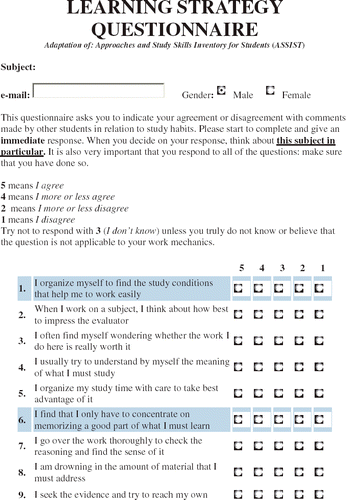

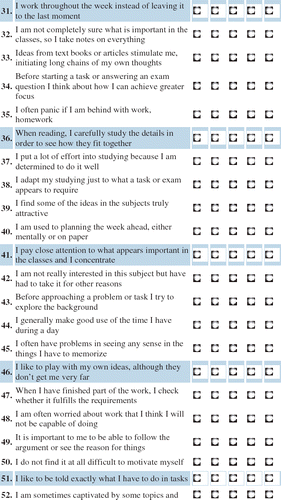
Appendix II.
Approaches (scales) and strategies (sub-scales) forming the ASSIST questionnaire.
Appendix III.
Spanish Adaptation of the Canfield Learning Study Inventory (CLSI).